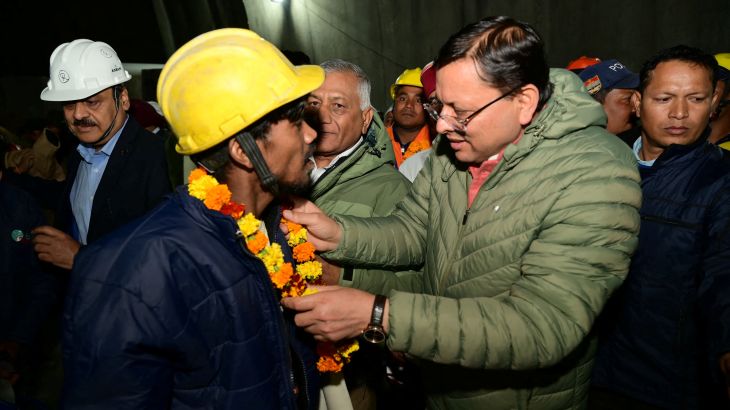How rat miners rescued workers from Indian tunnel after 17 days
After machines broke down, rat miners successfully rescued 41 workers trapped in India’s Uttarakhand tunnel.

Forty-one construction workers. Seventeen days. A nation’s hopes.
On Tuesday, rescue workers managed to bring India a dose of good news, saving 41 men who had been trapped under a collapsed tunnel in India’s Himalayan Uttarakhand state since November 12.
Keep reading
list of 4 itemsHow is India rescuing 41 workers stuck 17 days under a collapsed tunnel?
Photos: India workers trapped in Himalayan tunnel on verge of rescue
All 41 miners rescued from collapsed tunnel in India’s Uttarakhand
But after days of attempts, it wasn’t just high-tech tools that brought success — a team of so-called rat miners, practicing a craft that’s officially illegal, proved saviours too.
Here’s how the workers were rescued.
What happened to the Uttarakhand tunnel?
The under-construction Silkyara Bend-Barkot tunnel collapsed in Uttarakhand early morning on November 12. Low-wage construction workers, mostly from other northern and eastern Indian states, were consequently trapped in a 4.5km (3-mile) space underground.
The tunnel was part of Indian PM Narendra Modi’s ambitious, $1.5m Char Dham pilgrimage program which aims to connect four Hindu pilgrimage sites.
Authorities did not confirm the exact reason for the tunnel caving in, but the region is prone to landslides, earthquakes and floods. Geologist CP Rajendran told Al Jazeera that the Himalayan terrain contains highly fragile rock and is “constantly plagued by stability issues”.
Additionally, the tunnel did not have emergency exits and was constructed through a geological fault, a member of a panel of experts investigating the disaster told Reuters.
How did the rescue unfold?
Even though contact was established with the men in the tunnel a day after the collapse, rescue operations faced several roadblocks that delayed the process.
Excavator teams deployed heavy auger machines to dig both vertically and horizontally through the debris. The first drilling machine broke down after developing snags, halting the operation until a second machine was brought in. However, after horizontally drilling about three-quarters worth of debris, the second machine also broke down.
After this, six miners from central India were tasked with drilling through the remaining rock with hand-held drills late on Monday, using a technique known as rat mining.
In an effort that took over 24 hours, the miners worked in two teams of three each, with one person drilling, the second collecting the debris and the third pushing it out of the pipe.
The rescue was successful on Tuesday evening when all the workers were retrieved from the tunnel, as they were wheeled out by rescuers on stretchers through a 90cm (3 feet) wide steel pipe.
“When we saw them inside the tunnel after the breakthrough, we hugged them like they were family,” said Nasir Hussain, one of the six miners.
The technique of manual drilling that finally rescued the workers is known as rat mining.
What is rat mining?
Rat mining or rat-hole mining is the process of narrow tunnel excavation by manually digging through.
The technique earns its name from its resemblance to rats burrowing holes into the ground. The practice was commonly used in the northeastern state of Meghalaya where the holes were typically just big enough for the workers to descend and extract thin seams of coal. For this reason, children were usually tasked with this job.
The lack of ventilation and safety measures brought controversy to the method, which was banned by an environmental court in 2014.
But the practice has continued to exist in the largely unorganised mining sector.
At least 15 miners were killed in one such mine in Meghalaya after being trapped for more than a month until January 2019. Rights groups say 10,000 to 15,000 have died in such mines between 2007 and 2014.
However, some of the miners in the rescue operation said they got their training in Delhi and were not coal miners.
Uttarakhand’s Chief Minister Pushkar Singh Dhami, met some of the workers before they were taken to hospital, presenting them with traditional marigold garlands. Ambulances and helicopters were on standby at the entrance of the tunnel. Sweets were distributed and firecrackers were set off in celebration.
Despite the deployment of ambulances for the construction workers, “Their condition is first-class and absolutely fine … just like yours or mine. There is no tension about their health,” said Wakil Hassan, a rescue team leader.